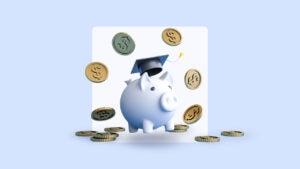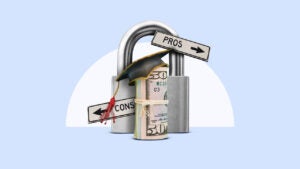Private student loans: What are they and how do they work?




Key takeaways
- Private student loans can help cover any funding gaps for college — ideally, after you’ve exhausted your federal loan eligibility and applied for grants and scholarships.
- Private loans often come with higher interest rates than federal loans and lack access to income-driven repayment plans or loan forgiveness programs.
- Private loans may also offer flexible repayment options, but eligibility often depends on creditworthiness or having a cosigner.
When grants, scholarships and federal student loans aren’t enough to cover college costs, private student loans can help make up the difference. For the 2024-25 academic year, the average cost of tuition and fees for in-state undergraduate students at public four-year colleges is $11,610, or $30,780 for out-of-state students, according to the most recent data from the College Board.
With such high costs, many students must turn to private student loans, which are offered by private institutions like banks and online lenders. Understanding their pros and cons, and the different types of private student loans can help you decide whether they’re the best financing option for you.
How do private student loans work?
Private student loans serve as a crucial financial resource when federal aid falls short. Evaluate the following components within the private student loan process to determine whether they fit your needs.
- Credit check: When you apply for a private student loan, a lender typically makes a credit inquiry to assess the risk of lending you money.
- Loan amounts: While federal loans have student loan limits, private loans often allow you to borrow up to the full cost of attendance, minus other financial aid. This can be especially helpful when dealing with out-of-state tuition costs.
- Interest rates: Unlike federal loans that only come with fixed rates, private student loans have fixed or variable rates. Starting interest rates for fixed-rate loans are typically higher than variable-rate loans.
- Repayment terms: Terms typically range from 5 to 20 years, with varying grace periods and payment options.
- Cosigner requirement: If you lack a strong credit history, a cosigner may be necessary to qualify.
- Deferment and forbearance: Some lenders offer temporary relief for borrowers facing financial hardship, though options are usually more limited than federal loans.
How to choose the best private student loan
It’s important to shop around before you decide on a lender. Compare loan options from multiple lenders — don’t just go with the first private student loan company you find. These steps can help you find the best one:
- Decide between a fixed and variable rate: Fixed rates stay the same, so payments are predictable. Variable rates can change over time, which may affect how much interest you pay. Think about your priorities and comfort with potential rate changes.
- Compare interest rates: Interest rates determine how much your student loan will cost in total. Compare private student loan rates to find the lowest one. Take advantage of prequalification offers so you can see what rate you qualify for without incurring a hard credit check on your credit report.
- Apply for the right loan for your degree: Some student loans are created for students in specific programs. For example, you will need to explore specific private loan programs if you’re pursuing an MBA or planning to obtain a medical school loan.
- Check the lender’s reputation: Look for lender reviews through the Better Business Bureau (BBB) or other reputable sources.
- Browse benefits: Some lenders offer specific benefits, like no late fees or long grace periods. Some might offer programs that make payments more manageable after graduation.
- Confirm school eligibility: Not all lenders work with every school, so verify that your institution is on the lender’s list.
Common private student loan lenders
| Lender | Fixed APR | Variable APR | Loan amounts | Loan terms |
|---|---|---|---|---|
| Ascent | 2.89%–14.93% | 4.34%–14.93% | $2,001–$400,000 |
5–15 years |
| SoFi | 3.18%–15.99% | 4.39%–15.99% | $1,000– 100% total cost of attendance | 5–15 years |
| ELFI | 2.99%–14.22% | 5.00%–13.97% |
$1,000–100% total cost of attendance |
5–15 years |
How to apply for private student loans
Follow these steps to apply for a private student loan:
- Check your credit report: Review your credit report to ensure it’s accurate and your accounts are in good standing before applying. It’s important to note that credit reports do not include your credit score.
- Research lenders: Compare rates, loans terms and eligibility requirements.
- Gather required documents: This includes proof of income, Social Security numbers and financial statements.
- Prequalify with multiple lenders: Get prequalified to compare offers without affecting your credit score.
- Submit your application: Complete the lender’s application process, providing necessary documentation.
- Review loan terms: Carefully review interest rates, repayment terms and fees before signing.
Pros and cons of private student loans
Private student loans have many benefits, but you should also consider the pros and cons before signing up.

Pros
- High loan amounts
- Quick application process
- Available for part-time college students
- Competitive interest rates

Cons
- Shorter repayment timelines
- No government-sponsored public service or teacher loan forgiveness
- No government deferment or forbearance
When to consider getting a private student loan
You should max out your federal student loans before turning to private student loans. That way, you’ll have access to income-driven repayment plans, loan forgiveness programs and extended deferment and forbearance periods.
If you still need money to cover tuition or other expenses, consider private student loans. Remember to only borrow what you need – the more you borrow now, the more you’ll have to pay back after you graduate.
Other scenarios where private loans make sense include:
- Your expenses suddenly change: If you’ve already maxed out federal student loans and your college expenses suddenly go up, private student loans can help you access more funding quickly.
- You don’t qualify for federal loans: International students may not qualify for federal loans, so private loans for international students could be the only source of funding.
- You have a specific plan to repay the money you borrow in a short amount of time: If you have a plan to repay your student loans over a few years, private student loans could end up being cheaper overall.
Federal vs. private student loans
| Key features | Federal loans | Private loans |
|---|---|---|
| Type of interest rate | Fixed rates only Note: Some federal loans don’t accrue interest while you’re in school or during deferment |
Variable or fixed interest rates |
| Loan amounts |
Undergraduates: Up to $57,500 aggregate Graduates: Up to the full cost of attendance |
Up to the full cost of attendance with most lenders |
| Grace period | 6 months | Up to 12 months |
| Cosigner required? | No | Often required |
| Repayment terms |
Standard term is 10 years; income-driven repayment plans available to extend repayment |
5 to 20 years |
| Loan forgiveness programs |
Available for all borrowers |
None |
|
Need good credit to qualify? |
No | Yes |
| Best for | Most borrowers |
Borrowers who have reached their federal loan limit |
Bottom line
While private student loans can be a valuable resource for covering education costs, they come with higher risks and fewer borrower protections than federal loans. Exhaust all federal aid options first and compare multiple private lenders to secure the best possible terms. Only borrow what you need to minimize repayment burdens after graduation.
Frequently asked questions
Why we ask for feedback Your feedback helps us improve our content and services. It takes less than a minute to complete.
Your responses are anonymous and will only be used for improving our website.






